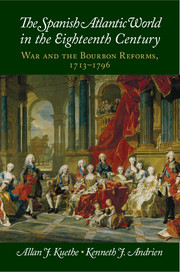Book contents
- Frontmatter
- Contents
- Introduction: War and Reform in Spain and Its Atlantic Empire
- I Alberoni, Patiño, and the Beginnings of Atlantic Reform, 1713–1736
- II The Second Wave of Reform, 1736–1763
- III Pinnacle of the Bourbon Reforms, 1763–1796
- 7 The First Phase of Reform under Charles III, 1763–1767
- 8 The Reorganization of Spain’s Atlantic Empire, 1767–1783
- 9 Adjustments and Refinements in the Reformist Agenda, 1783–1796
- Conclusion: War and Reform in the Spanish Atlantic World
- Timeline for the Spanish Atlantic World in the Eighteenth Century
- Bibliography
- Index
- Plate section
- References
7 - The First Phase of Reform under Charles III, 1763–1767
Published online by Cambridge University Press: 05 June 2014
- Frontmatter
- Contents
- Introduction: War and Reform in Spain and Its Atlantic Empire
- I Alberoni, Patiño, and the Beginnings of Atlantic Reform, 1713–1736
- II The Second Wave of Reform, 1736–1763
- III Pinnacle of the Bourbon Reforms, 1763–1796
- 7 The First Phase of Reform under Charles III, 1763–1767
- 8 The Reorganization of Spain’s Atlantic Empire, 1767–1783
- 9 Adjustments and Refinements in the Reformist Agenda, 1783–1796
- Conclusion: War and Reform in the Spanish Atlantic World
- Timeline for the Spanish Atlantic World in the Eighteenth Century
- Bibliography
- Index
- Plate section
- References
Summary
After acceding to the throne in 1759, King Charles III indicated his intention to revive and extend reforms in the Spanish Atlantic world begun by his half-brother Ferdinand and the Marqués de la Ensenada. While king of Naples (1734–1759), Charles had worked closely with his chief minister, Bernardo Tanucci, to make a series of ecclesiastical, fiscal, administrative, and economic reforms designed to centralize state power, and he was inclined to pursue a similar regalist agenda in his new kingdoms. Soon after taking the Spanish throne, Charles recalled Ensenada from exile and made him a councilor of State, indicating that he intended to shake Madrid from the political somnolence of the last years of Ferdinand’s reign. Although Charles and his ministers began planning key reforms, the Seven Years’ War intervened, leading to defeat and humiliation at the hands of Great Britain. The loss of Havana posed a great danger to the empire, since that Caribbean fortress protected the sea lanes to New Spain, the wealthiest Spanish possession in the Indies. Although Spain regained the key Caribbean stronghold in the Treaty of Paris ending the war, the king and his ministers recognized the need to shore up defenses in the Indies. Building on the achievements of Ensenada, they also planned a wide range of fiscal, administrative, commercial, and religious innovations aimed at strengthening Spain’s control over its Atlantic empire. The visita general of José de Gálvez to New Spain (1764–1772) implemented important new fiscal and administrative initiatives, but the first phase of reform under Charles III culminated with the extension of imperial free trade to Spain’s Caribbean Islands (1765) and the expulsion of the Jesuits (1767). Past wartime defeats had interrupted or reversed reform, but the threat of Britain’s unrivaled power spurred the king and his ministers to support widespread modernization throughout the Spanish Atlantic world.
- Type
- Chapter
- Information
- The Spanish Atlantic World in the Eighteenth CenturyWar and the Bourbon Reforms, 1713–1796, pp. 231 - 270Publisher: Cambridge University PressPrint publication year: 2014

